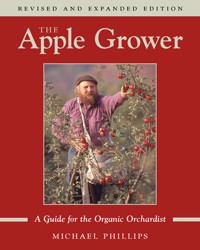| Home :: Herbalist :: Orchardist :: Family :: Farm |
 |
 |
Apple GrowerA Guide for the
|

|
Book Reviewby Carl DemrowNorthern Woodlands magazine
| ||
 more resources: Grow Organic Apples |
Michael Phillips' revised The Apple Grower has as much help as you'll find anywhere to get you to that first bite of pie or sip of cider. The previous edition, published in 1998, was the bible for many backyard orchardists and commercial organic growers. The new edition, boasting color photos and expanded and better-organized chapters, is a real treat for anyone interested in apples. The new edition's chapter on diseases and pests will be helpful to those left scratching their head about who or what is eating the apples or trees they are trying to grow. Phillips sprinkles tributes to other apple growers throughout the text. These persistent and dedicated souls, along with Phillips, are exploring uncharted territory: they are trying, without the use of traditional pesticides and chemicals, to keep ever-evolving pests and diseases away from trees that are themselves not evolving. All named apple varieties are genetic dead ends. A Macintosh today is genetically identical to a Macintosh from a century ago, but the bugs and diseases have spent that time evolving to break through the trees' defenses. Phillips presents intriguing ideas about orchard soils. Since people started growing apples in orchards, those orchard soils have largely been bacterially based, meaning that fertility has been maintained by the addition of bacteria-laden manure. Sheep and cattle were allowed to graze the grass and eat dropped apples, adding manure to the soils, and often the orchard was formerly pasture or hayfield, where manure was regularly added to maintain fertility. Bacteria-based soils are great for grasses and hay crops, but not necessarily for trees. Phillips argues that apple trees are still, well, trees, and like other trees, they prefer forest soils, which rely mainly on fungi to break down organic matter such as bark, wood, and other plant matter to maintain soil fertility. Phillips believes that this soil is what apple trees naturally want, and that it makes them healthier and better able to deal with pests and diseases. He has been experimenting with using fast-growing comfrey in his orchard, cutting it down to add rotting plant matter and to stifle the growth of grass, which can rob an apple tree's surface feeder roots of nutrients. He advocates adding composted branches, bark, wood chips, and even excess chunks of sheetrock to your orchard to promote the fungi in the soil and deter grasses. Phillips' style is more writerly than reference. His homespun stories about his many years of trying to outwit and outmaneuver the legions of apple-loving creatures are both entertaining and packed with tips. Phillips' extremely handy compendium of orchard tasks has always served as my basic plan of attack for what to do in my orchard, and the revised and expanded edition will be a welcome addition to my library. I have no doubt that over time it will take on the grimy, thumbed-through, and well-used look of my copy of the first edition of The Apple Grower. |

|
The Apple Grower: A Guide for the Organic Orchardist |
| Home :: Herbs :: Apples :: Contact Us :: Top |
recommend this page to a friend |
 |
send website feedback to the Heartsong Farm webster website by Sienna Moonfire Designs: SiennaMoonfire.com last updated 16 March 2018 :: noon Caspar (Pacific) time this site generated with 100% recycled electrons! | |
website design and images copyright © 2003-2024 Sienna Moonfire Designs
website content copyright © 2003-2024 Heartsong Farm all rights reserved, thank you | |